TL;DR: Heat Pump Tumble Dryer Running Costs
A heat pump tumble dryer costs around 20 to 30p per load to run in the UK, around 70 to 80% cheaper than a condenser or vented model. That means most households save about £200 a year on laundry alone.
If you’re wondering whether a heat pump dryer is worth the higher upfront cost, the short answer is yes. They really do deliver big savings. Based on both official figures and my own real-world testing, here’s what you can expect:
✅ About 20 to 30p per load compared with £1 for a condenser
✅ 70 to 80% lower energy use
✅ Quieter, gentler on clothes, no steamed-up rooms
✅ The cheapest tumble dryer to run, full stop
Read on for real-world usage data, annual running costs, and side-by-side comparisons.

Introduction
A heat pump tumble dryer can make a huge difference to both energy bills and everyday comfort. For our family of four (now teenagers), the tumble dryer has always been a necessary evil. The washing machine seems to run constantly, and while the best option is drying clothes outside, that isn’t realistic for much of the year in the UK.
I’m not an appliance reviewer by trade, just a UK homeowner who’s owned and run both a Bosch condenser tumble dryer and a Bosch heat pump tumble dryer. This article shares my real-world experience of both, backed up with energy data I’ve tracked over the years.
Table of Contents
About the Author
I’m Mick Wall, a UK homeowner and energy enthusiast who runs Energy Stats UK as a hobby project.
Over the years, I’ve tracked our household’s energy use, solar PV, battery storage, and smart tariffs and I share those insights here alongside my own real-world experiences. We’ve owned both a Bosch condenser tumble dryer and a Bosch heat pump tumble dryer, so this article is based on lived family use, not just spec sheets.
A big part of what I write about is how smart tariffs can help cut running costs for appliances like tumble dryers, EVs, and home heating.
👉 You can explore more of my articles and case studies in the Energy Stats UK blog, including my detailed guide to Octopus smart tariffs.

Is a Heat Pump Tumble Dryer Cheaper to Run?
Yes. Heat pump tumble dryers, the most energy-efficient tumble dryer type, are much cheaper to run than condenser models. In fact, they’re the cheapest tumble dryer to run, especially in the UK where electricity prices remain high
Living With a Condenser Tumble Dryer
Our old Bosch Exxcel 7 condenser tumble dryer worked, but it had some real downsides:
-
It used a shed load of energy.
-
It filled the downstairs with damp, moist air.
-
The clothes often came out almost too hot to touch.
-
Yes, the condensation container collected a lot of water, but plenty of it still ended up back in the room, steaming up windows and making the kitchen feel muggy.
It regularly pulled over 2 kW for 90–120 minutes, often using around 4 kWh in a single load.
By contrast, a modern heat pump tumble dryer uses a closed-loop system, so there’s no hot, damp exhaust escaping. At most, you might notice the room is slightly warmer after a long cycle, but without the condensation problems
Heat Pump Tumble Dryer vs Condenser Dryer: Real UK Comparison
When people ask about a heat pump tumble dryer vs condenser, the easiest way to see the difference is in the numbers. This Bosch side-by-side also makes it clear why the cheapest tumble dryer to run is always a heat pump model, even if the cycle times are longer.
Here’s what the official Bosch manuals say about energy use and drying times:
| Model | Type | Capacity | Energy Use (Cupboard Dry) | Cycle Time |
|---|---|---|---|---|
| Bosch Exxcel 7 | Condenser | 7 kg | 3.92 kWh | 90–120 mins |
| Bosch WTR88T81GB | Heat Pump | 8 kg | 1.20 kWh | 141–177 mins |
👉 As you can see, the heat pump model takes longer, but it uses less than a third of the energy per load.
Here’s snippets from the manuals for each model; Exxcel 7 Condenser on the left, WTR88T81GB Heat Pump on the right.


Cost to Run a Heat Pump Tumble Dryer per Hour
- A typical condenser dryer draws about 2 kW, which costs roughly 50p per hour at 25p per kWh.
- A heat pump model uses about 0.4 to 0.5 kW, or 10 to 13p per hour.
- That makes a heat pump tumble dryer about four to five times cheaper to run.
Making the Move to a Heat Pump Tumble Dryer
After research, we decided to stay with Bosch (we already had their washing machine and dishwasher). We chose the Bosch WTR88T81GB heat pump tumble dryer.
After more than three years of ownership, we love it:
-
Quieter than the condenser dryer.
-
No moist air discharge into the room.
-
Uses a lot less energy
Real-World Heat Pump Tumble Dryer Energy Use (UK Data)
Alongside the official Bosch figures, I wanted to see what the numbers looked like in the real world. So I ran a test on the Bosch WTR88T81GB heat pump tumble dryer, measuring energy use with a simple plug-in monitor. If you’re looking for a genuine Bosch heat pump tumble dryer review, this section shows the actual energy draw and costs in my own home.
I loaded cotton bedding and a mattress protector that had been washed and spun at 1400 rpm. Using the “Cupboard Dry Plus” programme, the dryer:
-
Started around 370 W and peaked at 530 W.
-
Ran for 1 hour 44 minutes.
-
Consumed just 0.78 kWh total.
In real usage, the heat pump tumble dryer vs condenser test shows a draw of 0.78 kWh vs ~4 kWh per load. A dramatic difference in running costs and wattage.
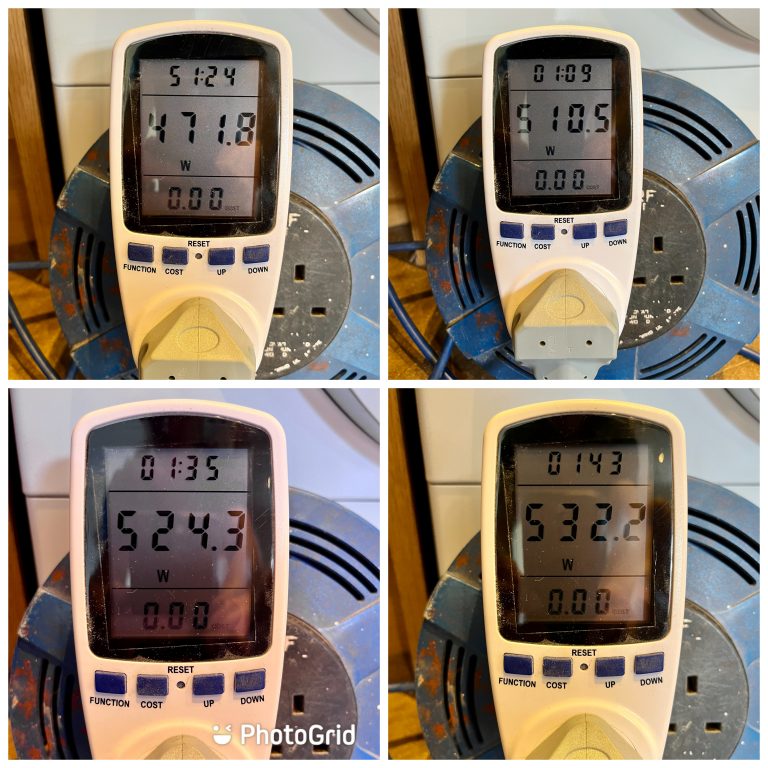
In this separate test run you can see where I trace and graph the usage throughout the drying cycle.
Started about 350 Watts and peaking towards the end at just over 500 Watts.
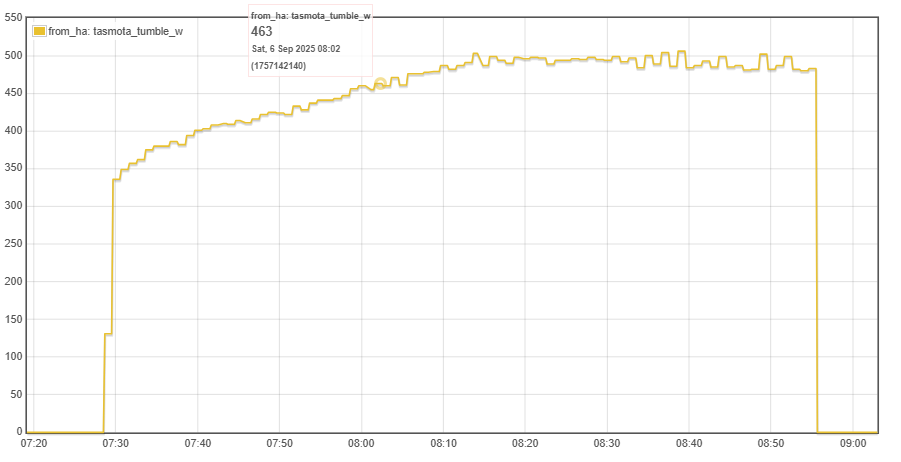
Annual Tumble Dryer Running Costs (Low, Medium, High Usage)
One cycle doesn’t tell the whole story. To see how much a tumble dryer really adds to your bills, here’s what the annual running costs look like for different usage patterns, based on 25p/kWh.
| Usage Level | Loads per Week | Condenser Dryer (4 kWh/load) | Heat Pump Dryer (1 kWh/load) | Annual Saving |
|---|---|---|---|---|
| Low | 2 | £104 | £26 | £78 |
| Medium | 4 | £208 | £52 | £156 |
| High | 7 | £364 | £91 | £273 |
👉 For a busy UK family, that’s hundreds of pounds saved every year — and well over £1,000 across the appliance’s lifetime.
🌞 Pro tip: If you’ve got solar PV, a battery, or a smart tariff, your real running costs can be even lower than the “heat pump” figures shown here.
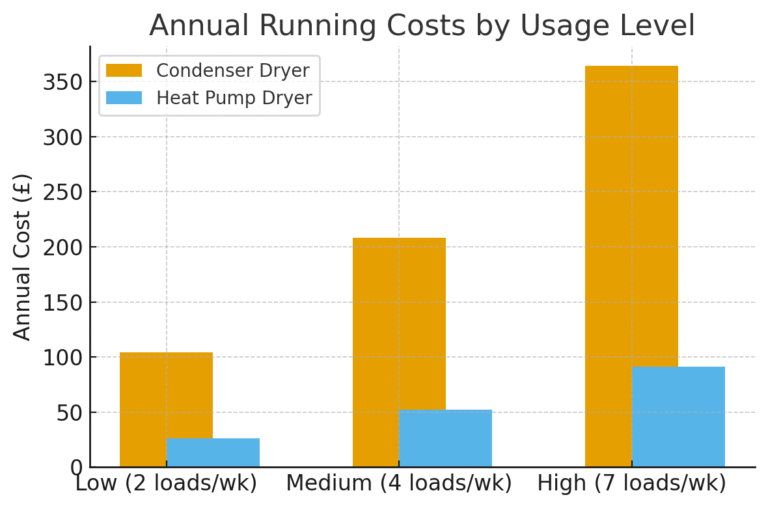
Seasonal Usage Patterns (2024 Data)
In 2024, our Bosch heat pump dryer used a total of 169 kWh, measured with a Local Bytes smart plug energy monitor.
Monthly Breakdown
| Month | Usage (kWh) |
|---|---|
| January | 20 |
| February | 22 |
| March | 23 |
| April | 13 |
| May | 9 |
| June | 8 |
| July | 10 |
| August | 8 |
| September | 10 |
| October | 13 |
| November | 18 |
| December | 15 |
| Total | 169 |
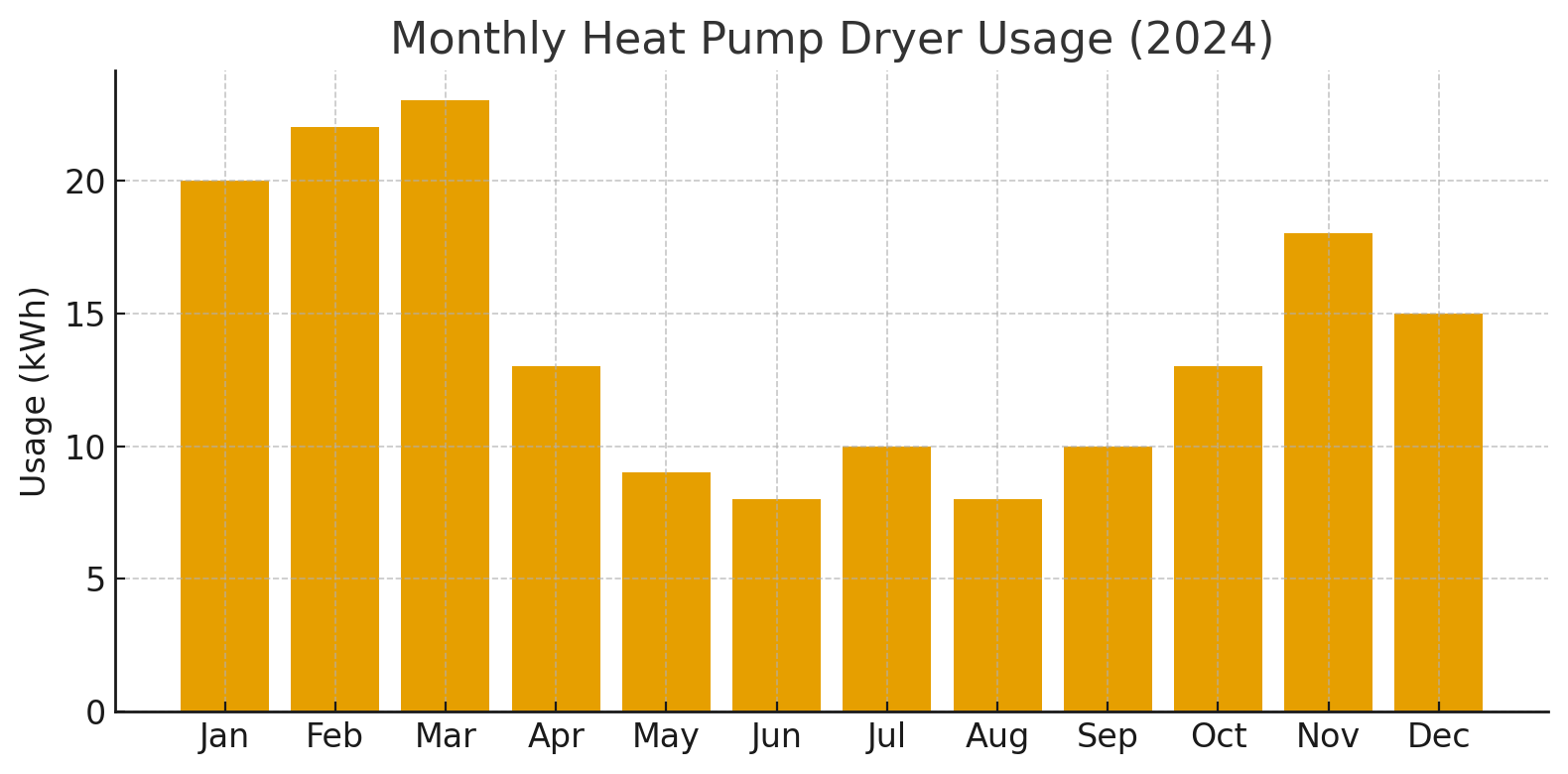
At an average UK electricity price of 25p/kWh, that’s £42.25 for the year.
Seasonal Totals (kWh + Cost)
| Season | Usage (kWh) | Cost (£) |
|---|---|---|
| Winter (Dec–Feb) | 57 | £14.25 |
| Spring (Mar–May) | 45 | £11.25 |
| Summer (Jun–Aug) | 26 | £6.50 |
| Autumn (Sep–Nov) | 41 | £10.25 |
| Total | 169 | £42.25 |
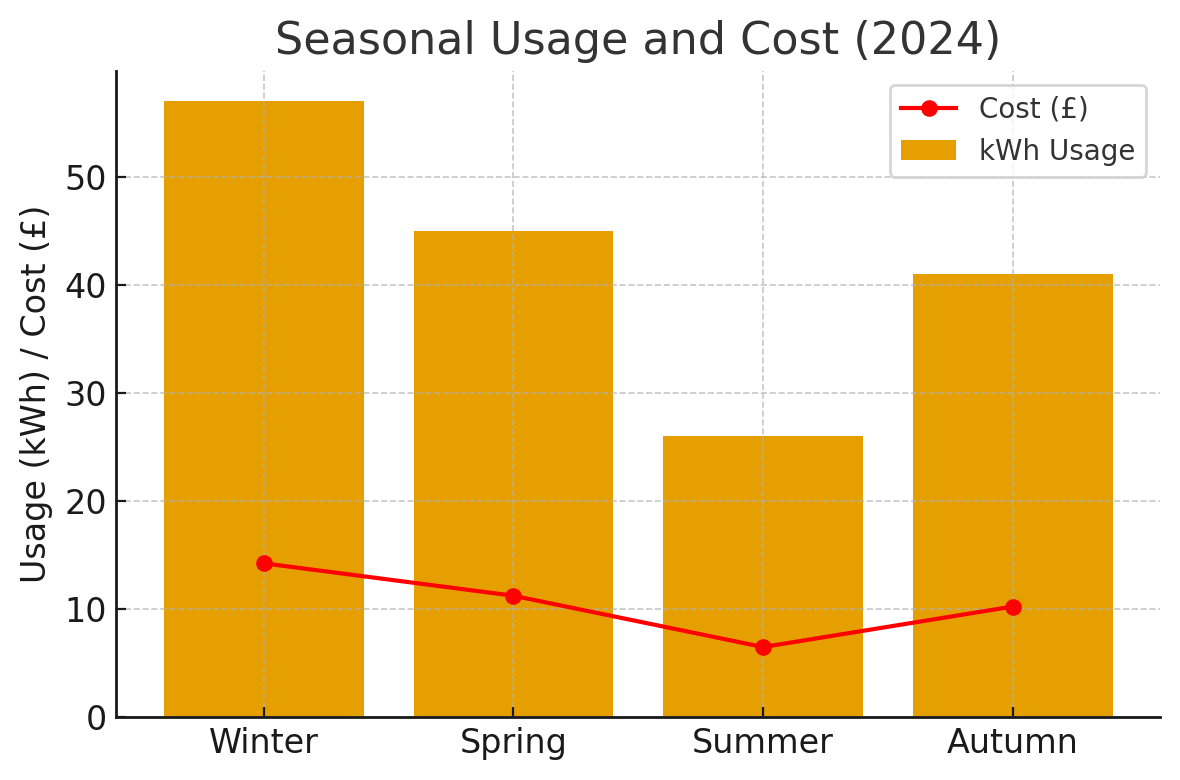
🌞 Solar + Heat Pump Dryer = Free Summer Laundry
From spring through autumn, many cycles can be covered entirely by rooftop solar PV, especially given the dryer’s low 370–530 wattage draw. The real difference shows up in winter, when usage is highest and solar is weakest. And that’s when the heat pump dryer really helps to keep household energy bills down.
Saving with Time-of-Use Tariffs
Pairing a heat pump tumble dryer with a time-of-use electricity tariff can cut costs even further.
Providers like Octopus Energy offer smart tariffs such as Agile, Cosy, Flux, and Intelligent Octopus Go, rewarding you for shifting usage into off-peak windows.
-
Daytime rate (25p/kWh): 20–30p per load.
-
Off-peak rate (7p/kWh with Intelligent Octopus Go): as low as 6p per load.
Pairing a heat pump tumble dryer with a smart tariff can make running costs even lower:
| Tariff | Price per kWh | Cost per Load (Heat Pump) | Annual Cost (3 loads/week) |
|---|---|---|---|
| Standard Flat Rate | 25p | 25–30p | ~£31 |
| Intelligent Octopus Go (off-peak) | 7p | 6–8p | ~£9 |
👉 That’s a saving of more than £20 per year on just three loads a week — and much more for higher-usage households.
Learn more about Time of Use (TOU) tariffs in my guide to Octopus smart tariffs.
If you do decide to change your supplier to Octopus Energy, you can claim £50 free credit when switching using my referral link. Thank you if you decide to do that.
💡 Heat Pump Dryer + Off-Peak Tariff = Super Savings
Solar and Battery Compatibility
One of the biggest differences between the old Bosch Exxcel 7 condenser dryer and the newer WTR88T81GB heat pump dryer is how well they work with solar PV systems and home batteries.
-
The condenser pulled 2 kW+, which meant it was almost impossible to run fully from solar unless it was a very sunny summer’s day. On batteries, it drained a typical 5–10 kWh unit very quickly.
-
The WTR88T81GB’s steady 370–530 W draw makes it:
-
Solar-friendly → more likely to be powered by rooftop panels, even on cloudy days.
-
Battery-friendly → uses only a fraction of storage per cycle.
-
Grid-friendly → lower peaks, easier to combine with EV charging or TOU tariffs.
-
A heat pump dryer isn’t just cheaper to run, it also fits naturally into a modern home energy setup, maximising solar self-consumption and reducing reliance on the grid.
What Do Other UK Users Say About Heat Pump Tumble Dryers?
Looking at reviews of heat pump tumble dryers across Reddit, MoneySavingExpert, and appliance forums, consistent themes emerge:
-
👍 Lower energy bills — families report noticeable drops in costs.
-
👍 Quieter operation — less intrusive than condenser models.
-
👍 Eco-friendly choice — reduced carbon footprint.
-
👎 Longer drying times — the most common complaint.
-
👎 Maintenance/reliability — some issues after 4–5 years if not cleaned regularly.
In short, real-world feedback echoes my own: lower running costs and quieter performance, in exchange for longer cycles and a need for basic upkeep.
Conclusion
Having lived with two very different Bosch tumble dryers, first the Exxcel 7 condenser and now the WTR88T81GB heat pump dryer, this Bosch tumble dryer review shows just how big a difference the switch has made.
The Exxcel hammered through ~4 kWh per cycle, left the room steamy, and produced clothes almost too hot to touch. The WTR88T81GB, by contrast, uses just 0.8–1.2 kWh per load, runs quietly, and dries clothes gently.
At today’s price of 25p/kWh, that’s 20–30p per cycle instead of £1.00, that’s a saving of 70–80p each time. For a family, that’s easily £200–£250 saved per year, and thousands over the lifetime of the appliance.
For homes with solar panels, batteries, or time-of-use tariffs, the savings are even greater, often pennies per cycle, or free from rooftop generation.
And don’t forget the lifestyle benefits: no steamed-up rooms, no overheated clothes, and longer-lasting fabrics thanks to gentler drying.
So, are heat pump tumble dryers cheaper to run? Absolutely yes.
✅ Highly recommended.
Are Heat Pump Tumble Dryers Worth It? (Final Verdict)
A heat pump tumble dryer uses around 70 to 80% less energy than a condenser dryer. That’s 20 to 30p per load instead of about £1, saving the average UK family £200 or more each year.
They’re quieter, gentler on fabrics, and work well with solar, batteries, and smart tariffs. Although they cost more upfront, the savings usually repay the difference in 12 to 18 months, and they keep paying off for years after.
If you want the cheapest, cleanest way to dry clothes, a heat pump tumble dryer is the clear choice.
✅ Lower running costs
✅ Quieter and cooler operation
✅ Compatible with solar and off-peak tariffs
✅ Pays for itself quickly
Heat Pump Tumble Dryer FAQ
How much does a heat pump tumble dryer cost to run in the UK?
A heat pump tumble dryer costs around 20 to 30p per load in the UK, based on electricity at 25p per kWh. A condenser or vented model costs about £1 per load, so a heat pump version is roughly 70 to 80% cheaper to run.
How much does it cost to run a heat pump tumble dryer per hour?
A heat pump dryer uses around 0.4 to 0.5 kWh per hour, which works out to 10 to 13p at typical UK electricity prices. A condenser model uses about 2 kWh, or roughly 50p per hour.
Are heat pump tumble dryers cheaper to run than condenser dryers?
Yes. A heat pump tumble dryer is usually four to five times cheaper to run than a condenser model. Expect savings of £200 or more per year for a busy household.
How efficient is a heat pump tumble dryer?
Modern heat pump dryers are among the most efficient household appliances. They use about 0.8 to 1.2 kWh per cycle, compared with 3.5 to 4 kWh for a condenser dryer, thanks to their closed-loop air system.
What is the wattage of a heat pump tumble dryer?
Most heat pump dryers run at 400 to 500 watts once up to speed, peaking slightly higher at the start of the cycle. That’s around one quarter of the draw of a typical condenser dryer.
Will a heat pump tumble dryer pay for itself?
Yes. Even if it costs about £200 more to buy, the energy savings usually cover that within 12 to 18 months of regular use. Over a ten-year lifespan, it can save several thousand pounds in electricity.
Referral information and free credit offer
If you find Energy Stats UK useful, there are a couple of easy ways to support the site and help cover hosting and server costs.
Thinking about switching energy suppliers?
Homeowners who join Octopus Energy using my referral link get £50 free credit after signing up. Business users get £100 free credit, and if you’re looking at solar or a heat pump, there’s also a £100 gift card through Octopus Tech.
Or, if you just want to say thanks, you can buy me a coffee.
You can also see more ways to support the site here via the likes of Plusnet broadband, Smarty Mobile, Havenwise remote heat pump control, Hetzner Cloud hosting and more.
Follow @energystatsuk on Twitter / X, Bluesky and Mastodon for daily tariff graphs and updates.
Note: The current and past performance of energy pricing is not necessarily a guide to the future.
![Heat Pump Tumble Dryer Cost: 20–30p Per Load [UK Data]](https://energy-stats.uk/wp-content/uploads/2022/05/IMG_5259-scaled.jpg)



